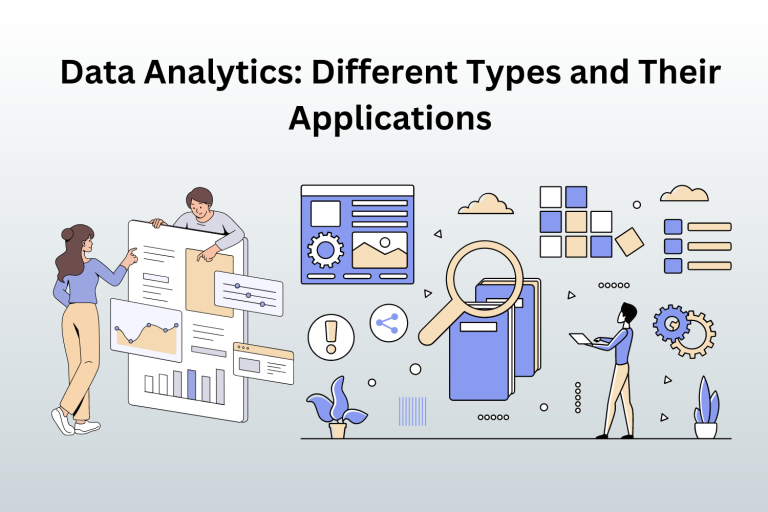Organisations use data analytics to improve desicsion-making, boost up growth, and perceive insights. Statistics-pushed strategies and insights require professionals to recognize the distinctive Types of Data Analytics and the way they’re carried out. A Data Analytics Certification makes you understand those better and apply data strategies for your operations. In this blog, we will go through the basics, features, and uses of descriptive, diagnostic, predictive, and prescriptive facts analytics.
Types of Data Analytics
Descriptive Analytics
Descriptive analytics compiles summary information from available historical statistics to shed light on patterns, trends, and occurrences from the past. By inspecting data to recognise the present situation, this type of analytics addresses the query “What took place” from an analytical perspective. Reports, dashboards, and visualisations that bring critical metrics and KPIs to stakeholders are often created with the use of descriptive analytics. Website visitors analytics, consumer segmentation reports, and sales reviews are all examples of descriptive analytics.
Diagnostic Analytics
Diagnostic analytics is the way to go in case you want to know why something took place or what elements contributed to a selected result. This analytics method aims to find out “Why did it occur?” with the aid of correlations, patterns, and outliers within the facts. By using diagnostic analytics, companies can recognize and deal with customer concerns via identifying and addressing their underlying reasons. Outlier detection, correlation evaluation, and root cause analysis are examples of diagnostic analytics programs.
Predictive Analytics
Predictive analytics makes use of past statistics and statistical algorithms to predict results, patterns, and actions. Analytical techniques that are looking to predict future events with the aid of building models from existing facts patterns and correlations are called ” what is likely to happen?” analytics. Organisations can optimise resource allocation, anticipate system failures, and expect customer preferences with the help of predictive analytics. Predictive maintenance, demand forecasting, and churn prediction are examples of the many uses of predictive analytics.
Prescriptive Analytics
Prescriptive analytics indicates interventions and actions to improve future consequences. An essential goal of scenario-based analytics is to offer a solution to the query “What should we do?” through considering and weighing the feasible outcomes of alternative actions. With prescriptive analytics, companies can steer proactive strategies and make data-pushed choices. Supply chain optimisation, dynamic pricing, and personalised pointers are examples of the way prescriptive analytics can be applied.
Real-time Analytics
Real-time analytics targets to facilitate decision-making by analysing information in actual-time as it’s being generated. This analytics technique seeks to pick out patterns, outliers, and trends in real-time by processing and analysing data streams. The potential to screen operational performance, locate fraud, and respond to important events in actual time is made possible with the aid of real-time analytics. Detecting fraud, analysing sensor statistics, and dynamic pricing are all examples of real-time analytics.
Text Analytics
Text analytics, on occasion known as text mining or NLP, looks to derive insights, sentiment, and meaning from big quantities of unstructured textual statistics. Information gleaned from textual resources, together with opinions, emails, and social media, is the number one emphasis of this analytics subfield. Businesses can realise consumer comments, identify sentiment trends, and derive valuable insights by means of analysing text data. Among the various uses of textual content analytics are sentiment evaluation, named entity reputation, and subject matter modelling.
Spatial Analytics
Finding trends, patterbs, and correlations in geographical or area-based data is the goal of spatial analytics. Geographic information systems (GIS), maps, and different spatial evaluation tools are the foundations of this branch of analytics. By analysing location information, spatial analytics aids companies in optimising logistics, making plans infrastructure tasks, and spotting market possibilities. Analysing potential web sites, optimising routes, and creating demographic maps are all examples of uses for spatial analytics.
Conclusion
Data analytics is locating valuable insights into data via diverse techniques and methodologies. To help organisation success through data-pushed strategies, professionals are pursuing Data Analytics Certification, which calls for them to understand the various sorts of data analytics and how to follow them. There are many analytics, each with benefits companies can use to enhance their operations, find out new insights, and make better choices. Professionals learn how to use numerous varieties of statistics analytics to their fullest capacity. This will permit them to drive innovation, enhance overall performance, and increase competitiveness of their agency.


